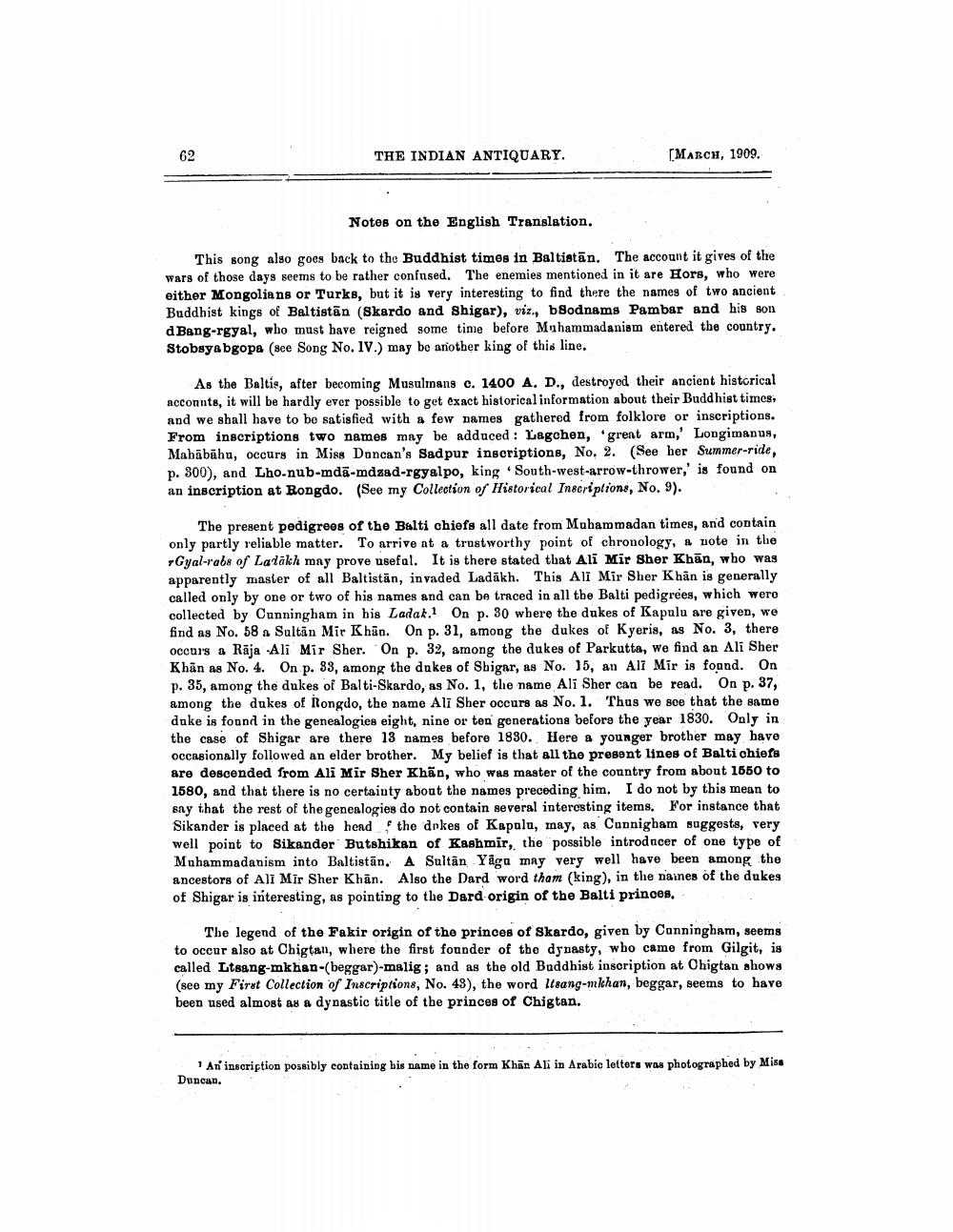________________
THE INDIAN ANTIQUARY.
[MARCH, 1909.
Notes on the English Translation,
This song also goes back to the Buddhist times in Baltistān. The account it gives of the wars of those days seems to be rather confused. The enemies mentioned in it are Hors, who were either Mongolians or Turks, but it is very interesting to find there the names of two ancient Buddhist kings of Baltistan (Skardo and Shigar), viz., bodnams Pambar and his son d Bang-rgyal, who must bave reigned some time before Muhammadaniem entered the country. Stobsya bgopa (see Song No. IV.) may be another king of this line.
As the Baltis, after becoming Musulmans e. 1400 A, D., destroyed their ancient historical acconnte, it will be hardly ever possible to get exact historical information about their Buddhist times, and we shall have to be satisfied with a few names gathered from folklore or inscriptions. From inscriptiong two names may be adduced : Lagchen, great arm,' Longimanus, Mahābāhu, occurs in Miss Duncan's Sad pur inscriptions, No. 2. (See her Summer-ride, p. 300), and Lho.nub-mdā-mdzad-rgyalpo, king South-west-arrow-thrower,' is found on an inscription at Rongdo. (See my Collection of Historical Inscriptions, No. 9).
The present pedigrees of the Balti chiefs all date from Muhammadan times, and contain only partly reliable matter. To arrive at a trustworthy point of chronology, a note in the Gyal-rabs of Ladakh may prove usefal. It is there stated that Ali Mir Sher Khān, who was apparently master of all Baltistan, invaded Ladakh. This Ali Mir Sher Khan is generally called only by one or two of his names and can be traced in all the Balti pedigrees, which wero collected by Cunningham in his Ladak.1 On p. 30 where the dukes of Kapulu are given, we find as No. 58 a Sultan Mir Khān. On p. 31, among the dukes of Kyeris, as No. 3, there occurs a Rāja Ali Mir Sher. On p. 32, among the dukes of Parkutta, we find an Ali Sher Khan as No. 4. On p. 83, among the dukes of Shigar, as No. 15, an Ali Mir is found. On p. 35, among the dukes of Balti-Skardo, as No. 1, the name Ali Sher can be read. On p. 37, among the dukes of Rongdo, the name Ali Sber occurs as No. 1. Thus we see that the same duke is found in the genealogies eight, nine or ten generations before the year 1830. Only in the case of Shigar are there 13 names before 1830. Here & younger brother may have occasionally followed an elder brother. My belief is that all the present lines of Balti chiefs are descended from Ali Mir Sher Khan, who was master of the country from about 1650 to 1580, and that there is no certainty about the names preceding him. I do not by this mean to sny that the rest of the genealogies do not contain several interesting items. For instance that Sikander is placed at the head the dokes of Kapulu, may, as Cunnigham suggests, very well point to Sikander Butshikan of Kashmir, the possible introducer of one type of Muhammadanism into Baltistān. A Sultan Yaga may very well have been among the ancestors of Ali Mir Sher Khān. Also the Dard word tham (king), in the naines of the dukes of Shigar is interesting, as pointing to the Dard-origin of the Balti princes,
The legend of the Fakir origin of the princes of Skardo, given by Canningham, seems to occur also at Chigtan, where the first founder of the dynasty, who came from Gilgit, is called Ltsang-mkhan-(beggar)-malig; and as the old Buddhist inscription at Chigtan shows (see my First Collection of Inscriptions, No. 43), the word ltsang-michan, beggar, seems to have been used almost as a dynastic title of the princes of Chigtan.
Ar'inscription possibly containing his name in the form Khan Ali in Arabic letters was photographed by Miss Duncan,




